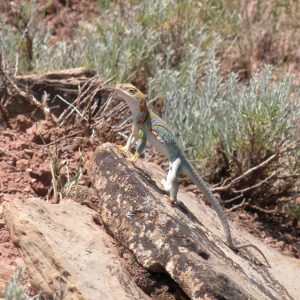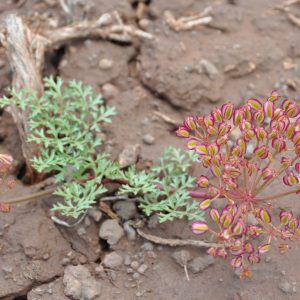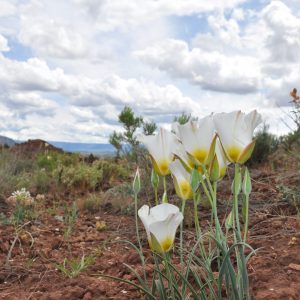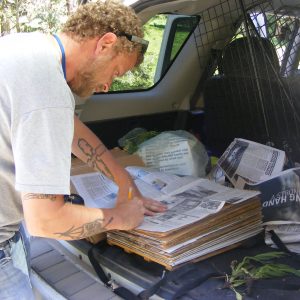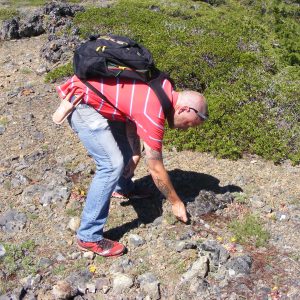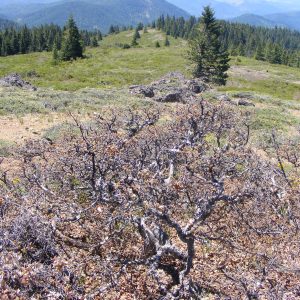It’s hard to believe that almost 2 months of my internship are done. This past month has been a whirlwind of work-filled weeks and busy weekends. The biggest adventure of this past month, and perhaps of my entire internship, was a two night float trip on the Gila River. I had never before been on such a trip. It was physically difficult due to the extremely low levels of water flow. In fact, it was the lowest flow trip that any BLM team from our office had ever completed. This trip began my month of animal encounters, with a rattlesnake at our campsite the first night, and the next day we encountered seven different Desert Big Horn Sheep, including a mom and her lamb at the riverside getting a drink of water. During the trip we used an electro-fisher and seine nets to monitor fish populations at four different sites along the river. In addition to our sampling efforts, our days involved approximately 10 hours of paddling, dragging loaded canoes over rock beds and plenty of getting in and out of the boats! Needless to say it took a while to feel fully recovered!
I feel like I was not very detailed in my last entry with exactly what I am doing during our fish monitoring/removal work, so I wanted to take the opportunity to talk about it now. When we plan to set nets in Bonita Creek (as we did 4 times in the past month), it is a two-day process. We leave the office at approximately 12-12:30 and drive about 45 minutes to the Gila Box National Riparian Conservation Area. There are many different areas of Bonita Creek that have perennial pools (ie, they have water year-round). We typically try to set our nets either in large pools or areas of the creek that have running water. The most important thing is that the water be deep enough to mostly submerge the nets in, otherwise we run the risk of a raccoon or other animal trying to get into the nets to get the dog food (which we use as bait). We allow the nets to sit overnight and collect fish. The fish enter the traps, but due to the design of the traps, cannot leave. However, they do still swim about inside the trap. In this manner the fish are not harmed and remain alive to be measured and put back (if they are native), or measured and removed (if they are non-native). The second day of our effort involves leaving the office at 6 AM and once we arrive we collect all the nets together and process the fish trapped inside.

One of the pools we set in for our Green Sunfish Removal Efforts

Example of how our nets are set in the water. Note how the black Promar is not 100% submerged. Sometimes Sonoran Mud Turtles enter the net and we leave them an air pocket.

Example of how our nets are set in the water, we usually tie them to a tree or something solid on the bank to prevent the nets from being washed downstream in case a storm surge comes.
We use two types of nets in Bonita Creek: Promar Mesh and Metal Minnow. They have very different mesh sizes and typically catch different compliments of fish (based on size). The Promar tend to catch most of the Bullfrog Tadpoles, Sonoran Suckers, Gila Chub, and the non-native Green Sunfish and Bullhead Catfish. The Metal Minnow traps tend to catch mostly the smaller, non-native Mosquito Fish and Flatheads, as well as young/small individuals of the other species.

We collect all of our nets together in order to count and measure the fish within.

We dump the fish out of the nets and into the blue bucket. Then they are measured on the white board and recorded. Natives are placed back in the pool while invasives are placed into the white bucket that contains a fish sedative.

Includes native Gila Chub, Bullfrog Tadpoles and native Sonoran Suckers.
Using these nets almost every week leads to damages. A large quantity of time this past week has been devoted to repairing both Promar and Metal Minnow nets in preparation for a team of contract workers to come and camp out at Bonita Creek for 3 full days of fishing aimed at causing a collapse in the breeding population of Green Sunfish. As a side note, in Bonita Creek we have also had a fair share of animal encounters. We have seen white-tail deer, juvenile brown bear, as well as a grey fox.
We also visited Pategonia, AZ one day and assisted Caleb (one of the other interns who traveled with us to Boise for the SOS training course). He works for Borderlands Restoration. We helped him to complete their monthly survey of pollinator supporting plants at 100 random points on a parcel of Nature Conservancy land. The group is trying to formulate a nectar-calendar for their area. They are going to look at when they currently have plants that support pollinators, and what periods on the calendar currently do not have plants to support pollinators. Then, once they have completed this process, they will plant new species into their system that will fill in the gaps. They hope that by creating a year-round supply of food for pollinators, they may cause a chain reaction that will allow their system to grow and recover from the bottom of the food chain, up to the top. I think it is a very interesting concept and will be excited to hear about the progress of this project in the future!
We also began work on creating a brand new BLM Junior Explorer Booklet. It will be called “Across BLM Lands: Desert Fishes and their Aquatic Habitats”. It has been very educational to collect information for this booklet and to create different activities in order to communicate the information to 8-12 year olds. I am excited that by the time I leave this internship I shall (hopefully) have a booklet to take home that I co-created!
The last major thing that we have done is two hiking trips in the Aravipa Canyon Wilderness to Horse Camp Canyon. The pools that remain in this canyon during the dry season are a sort of refuge habitat for Green Sunfish, from which their population survives the monsoons and then re-colonizes the main stretch of the stream in the spring. The hike out to this site is arduous to an inexperienced hiker like me, to say the least. It is 5.5 miles of hiking each way. In total we hike approximately six hours each time we go out there. The trips are very physically demanding as the route requires hiking over a variety of surfaces as well as in and out of the creek for long periods of time.
Our first trip was to pick up 10 Promar nets and 10 Red Promar nets that had been set the night before by another research team. Between our efforts pulling those nets, seining, and the efforts of the research team the day previous we removed approximately 600 Green Sunfish. It was an incredible day for wildlife as well! We saw a black bear on the road, on the drive into the Wilderness, and we also saw four white-tailed deer within 10 minutes of hiking. We thought that would be the extent of our wildlife experiences for the day. However, around an hour into our hike we rounded a corner and saw a Mama black bear and two cubs. When the mother noticed our presence, she sent her cubs up a tree. We were able to walk around them at a safe distance and kept on with our day. We also saw the same family group on the hike back out. As if those weren’t enough, we also encountered a fully coiled and rattling rattlesnake on our hike out as well. Jeff was the one who startled it, and I am very glad it wasn’t me; I am not 100% sure how I would have reacted. At the very end of our hike out to the truck, Rosalee and Heidi came across a troubled juvenile red tail hawk from the Creek. Rosalee formerly worked at Wildlife Rehab Centers and so she was able to help secure the bird. Heidi and Jeff took the bird to Tucson the following day and apparently it will make a full recovery. Our second trip into Aravipa a week later didn’t involve any pre-set nets, we only used seine netting and we removed 400 Green Sunfish. Though it was not nearly as exciting for wildlife, we did see a juvenile bobcat on drive in.
It is incredible to see so much life thriving out here in the desert. The last thing that I expected when I signed on to work in the desert was to almost constantly encounter animals in their natural habitats. I have been incredibly lucky so far and I can only hope to continue to see more animals. My goal/dream is to see a coati in the wild. My last internship was at the Oakland Zoo, which involved taking care of our troop of six coati, so I am very fond of these animals and would be beyond excited to be able to see them while I am here in Arizona. Even bought myself a coati hat when I visited the Desert Museum in Tucson last weekend [which is well worth the trip and I would highly recommend it!]

The Coati Hat that I bought at the Desert Museum in Tucson
This will be my first weekend to stay in Safford, with nothing to do, since the beginning of my internship. It will be amazing to relax and recover from a long month of work.
Until next time! 🙂





















